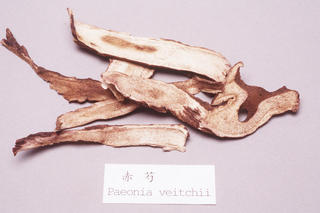Paeonia veitchii
Contents
Nomenclature
Other Names:
Historical Use of Paeonia veitchii
Paeonia veitchii in Traditional Chinese Medicine
Background
Chishaoyao ³àÉÖÒ©
Chinese Name (pinyin): Chishao
Chinese Name :
Common Name :Red Peony Root
Specific Name : Radix paeoniae rubra
Scientific Name:
Collection : The drug is collected in spring and autumn, removed from rhizome, rootlet and dried in the sun.
Description : Cylindrical, somewhat curved, 5 - 40 cm long, 0.5 - 3 cm in diameter. Externally brown, rough, longitudinally furrowed and wrinkled and showing rootlet scars and transversely prominent lenticels, sometimes the outer bark easily exfoliated. Texture hard and fragile, easily broken, fracture chalk white or pink, bark narrow wood with distinct radial striations. Sometimes with cleft, odour slightly, taste somewhat bitter, sour and astringent.
Identification : 1.Transverse section: Cortex consisting of a few layers of brown cells. Parenchymatous cells in cortex elongated tangentially. Phloem relatively narrow, cambium in a ring. Xylem rays relatively broad, vessels arranged radially, accompanied by wood fibres. Parenchymatous cells containing clusters of calcium oxalate and starch granules.2.To 0.5g of the powder add 10 ml of water, boil and filter. To the filtrate add a drop of ferric chloride TS, a bluish black precipitate is produced.3.To 0.5 g of the powder add 10 ml of ethanol, shake thoroughly fro 5 minutes and filter. Evaporate the filtrate to dryness and dissolve the residue in 2 ml of ethanol as the test solution. Dissolve paeoniflorin CRS in ethanol to produced a solution containing 2 mg per ml as the reference solution. Carry out the method for thin layer chromatoggraphy (Appendix Vl B), using silica gel G as the coating substance and chloroform ethyl acetate-methanol-formic acid (40:5:10:0.2) as the mobile phase. Apply separately to the plate 4 µl of each of the two solutions. After developing and removal of the plate, dry it in the air. Spray with 5% solution of vanillin in sulfuric acid, visualize with a current of hot air until the spot reveal clearly. The blue purple spot in the chromatogram obtained with the test solution correspond in position and colour to the spot in the chromatogram obateined wityh the reference solution.Assay: Reference preparation: Dissolve 5 mg of paeoniflorin CRS, accurately weighed and dried previously to constant weight at 80ºC in dehydrated ethanol to a 2 ml volumetric flask, add dehydrated ethanol to volume and mix well (containing 2.5 µg of paeoniflorin per µl)Preparation of Standard Curve: Carry out the method for thin layer chromatography (Appendix Vl B) using silica gel GF254 as the coating substance and chloroform methanol (5:1) as the mobile phase. Apply accurately in strips to the plate, 10, 30, 50, 70 and 90 µl of the reference solution separately. After developing and removal of the plate, dry it in the air. Examine under ultra violet light (254 nm), scrape off the strips corresponding to paeoniflorin and an equal area of the coating gel from the same plate as the blank. To 10 ml cetrifugal tubes separately, add accurately 10 ml of absolute ethanol, shake thoroughly for 3 minutes, allow to stand for 10 minutes, centrifuge. Carry out the method for spectrophotometry (Appendix V A), measure the absorbances of the supernatants at 230 nm and plot the standard curve, using absorbance as ordinate and concentration as abcissa.Procedure: Weigh accurately 0.5 g of the powder of medium size to a stoppered conical flask, add accurately 10 ml of dehydrated ethanol, macerate at 40ºC on a water bath for four hours and filter. Carry out the method for thin layer chromatography (Appendix Vl B), using silica gel GF254 as the coating substance and chloroform methanol (5:1) as the mobile phase. Apply in strips separately to the plate 50 µl, accurately measured of the above filtrate and 10 µl of the reference solution beside. After developing and removal of the plate, dry it in the air, examine under ultra violet light (254 nm). Scrape off the strips in the chromatogram obtained with the test solution corresponding to the strips in the chromatogram obtained with the reference solution. To a 10 ml centrifugal tube. Scrape off an equal area of silica gel GF254 from the same plate as blank. To each tube add accurately 10 ml of absolute ethanol, shake thoroughly for 3 minutes. Allow to stand for 10 minutes. Centrifuge, measure the absorbance of the supernatants at 230 nm. Read out the weight of paeoniflorin (µg) in the test solution from the standard curve and calculate. It contains not less than 2.0% of paeoniflorin (C23H26O11).
Processing : Eliminate foreign matter, grade according to size, wash clean, soften thoroughly, cut into slices and dry. Occurring in cylindrical slices, 0.5 - 3 cm in diameter. 0.3 - 0.5 cm thick, cut surface yellowish white or pink.
Action : To remove heat from blood, to eliminate blood stasis, and to relieve pain.
Indication : maculation in epidemic disease; spitting of blood, epistaxis; inflammation of the eye; pain in the chest and costal regions; amenorrhea, dysmenorrhea; mass formation in the abdomen; traumatic injuries; boils and sores
Precautions : Incompatible with Rhizoma et Radix Veratri.
Dosage : 6 to 12 g.
Storage : Preserve in a ventilated dry place.
Synonymns for Paeonia veitchii
Patent Medicines and Medicines with Multiple Ingredients that include Paeonia veitchii
Pharmaceutical Information
Chemical Constituents
Evidence or the Use of Paeonia veitchii in the Treatment of Epilepesy
Basic Science
Animal Studies
Cohort, Case-Control and Non-Randomized Trials
Randomized Controlled Trials
Meta-Analysis
1st Five Results: pubmed search
